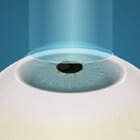What is farsightedness?
Farsightedness (hyperopia) is an eye disorder in which a person can hardly distinguish close objects. With high hyperopia, vision in the distance is also blurred.
With hyperopia, light rays passing through the refractive media of the eye (cornea, lens, and vitreous body) are not focused on the retina but on the plane behind it.
Causes of hyperopia
Hyperopia is caused by a mismatch between the power of the eye’s optical system and its length. The main causes are:
Acquired farsightedness
This is an ailment that occurs in the course of life due to any external factors, such as eye injury, eye diseases such as lens displacement (aphakia) or after cataract surgery.
Congenital farsightedness
Most children are usually born with farsightedness. As the child grows, the length of the eyeball increases, and farsightedness disappears. But it happens that the eye does not grow enough and then the disease persists, passes into adulthood. It is very important to identify hypermetropia at an early stage, since without proper correction it can provoke various pathologies, such as strabismus.
Age hypermetropia
The disease is associated with age-related changes in the body. When the lens of the eye loses its original properties, it becomes less flexible and elastic, as a result of which its refractive properties deteriorate and age-related farsightedness develops.
Types of farsightedness
Farsightedness is measured in diopters, which is the unit of measure for optical power. In hypermetropia, diopter errors are classified as positive and are written with a plus: +1, +2, and so on. The higher the number, the higher the level of farsightedness.
As a rule, there are three degrees of farsightedness: weak, moderate (medium) and high.
Mild hyperopia in both eyes
up to +2 diopters – with a weak degree of farsightedness, the eyes quite easily adapt to visual error. In everyday life, mild hypermetropia may even be invisible to humans. Therefore, it is so important to regularly undergo an examination by an ophthalmologist at the Excimer clinic (Kyiv) in childhood and adulthood. Only during the diagnosis of vision in a specialized clinic, the doctor will be able to determine such a pathology of vision as hypermetropia of the 1st degree and prescribe the correct treatment.
Hypermetropia of moderate degree in both eyes
from +2 to +4 diopters – with hypermetropia of the 2nd degree, it is already difficult for a person to see objects close up and they have to be placed further away in order to make out what is written. At the same time, distant objects are clearly visible. Hypermetropia of an average degree in both eyes in the absence of correction is accompanied by increased eye fatigue, pain in the frontal part of the head and the bridge of the nose.
High degree hypermetropia in both eyes
from +5 diopters and above – with a high degree of hypermetropia, a person sees poorly both far and near, it is difficult for him to focus on any objects. Farsightedness of a high degree is accompanied by severe headaches, a feeling of fullness in the eyes and a feeling of sand.
Cause of farsightedness
Hyperopia is caused by a mismatch between the power of the eye’s optical system and its length. The main causes are:
- Incorrect (shortened) shape of the eyeball. The normal length of an adult eye is 23-24 mm, but with hyperopia, it is less than 23 mm.
- Too weak refraction of light rays by the optical system of the eye (cornea or lens).
Farsightedness is a type of refractive error in which light rays focus at a point behind the retina instead of on it, resulting in blurry vision when looking at close objects.
So why does farsightedness develop? Children are usually born with farsightedness, but as time passes, the eyes grow and vision becomes 100%. Unfortunately, not everyone has, sometimes farsightedness persists even at an older age.
The most common cause of farsightedness is heredity. At least some of the genes involved in farsightedness play a large role in eye development, especially in determining the length of the eyeball (front to back, also known as axial length). It is possible that environmental factors also influence the risk that a person will be farsighted, but these are not yet well understood.
Also, the causes of farsightedness can be:
- diabetes;
- tumors;
- macular hypoplasia – a rare disease involving underdevelopment of the macula, a small area on the retina.
After 40 years, age-related farsightedness develops, the cause of which is age-related physiological changes in the human eye apparatus.
These situations require careful diagnosis by an ophthalmologist and appropriate treatment. In Kyiv, all these procedures can be performed at the Excimer ophthalmological center.
How to test for farsightedness
For the diagnosis of farsightedness (including latent) a basic comprehensive eye examination is used, which includes an assessment of refraction and an eye health check.
The refraction score determines if you have vision problems such as nearsightedness and farsightedness, astigmatism and presbyopia. You may also be examined on various devices to check how you see at a great distance or up close.
The examination is carried out with the obligatory expansion of the pupil to check the health of the eyes and the condition of the fundus. Please note that after this you will not see clearly for several hours, and you will still have photosensitivity.
How to check vision for farsightedness at home? A signal to see a doctor may be the inability to clearly see objects or objects near. If you notice that the child or you yourself take, for example, a book away to view the text, then it’s time to visit an ophthalmologist.
Can farsightedness be cured?
Farsightedness can be corrected with glasses or contact lenses, as well as refractive surgery. The goal of treatment is to help focus light on the retina.
If you ask a doctor if it is possible to correct vision with farsightedness, then he will be able to give an accurate answer only after you have undergone a comprehensive diagnosis.
So, for young people with a mild degree of farsightedness, a hardware method of treatment can be effective. Since the lenses inside the eyes are quite flexible, and are able to compensate for this condition at a young age. When treating high to moderate hypermetropia, you may need corrective lenses or glasses to improve near vision. This is especially true with age-related farsightedness, when the natural lens of the eye loses its elasticity.
Also, to correct farsightedness, an ophthalmologist can offer surgical methods to solve the problem, these include: laser vision correction, the introduction of an intraocular lens and the use of a phakic lens.
Most refractive surgical procedures are used to treat nearsightedness, but they are also effective in treating farsightedness.
Farsightedness surgery
To correct farsightedness of varying degrees, laser vision correction is actively used. Laser surgery reshapes the cornea and can eliminate the need to wear glasses or contact lenses and can be an effective treatment for blurry vision. Farsightedness surgery gives high quality vision and is very popular among patients.
At our Excimer Ophthalmological Center in Kyiv, we can offer you the following types of laser correction of farsightedness:
— LASIK.
– 5D-Eye LASIK.
— Thin flap technique.
— Femto-Lasik.
Also, in our clinic, a unique procedure is successfully applied – laser correction of age-related farsightedness. The fact is that the restriction for performing refractive surgery is the age of 45 years and older. Our program PresbyLasik is designed to solve the problem with vision in patients who have reached this age threshold.
Laser correction of age-related farsightedness involves two methods:
— PresbyLasik.
— Presby FemtoLasik.
It should be borne in mind that farsightedness surgery is performed if vision is stable for a year and there are no sharp jumps in diopters.
Recovery after laser correction of farsightedness occurs relatively quickly and the next day patients see 100%. For many people, it is important to guarantee the correction of farsightedness, and the method of treatment and price – these factors are already becoming of secondary importance.
Take good care of your eyes and follow your doctor’s recommendations to ensure quality vision.
How to improve vision with farsightedness
Tips to help protect your eyes and improve vision in hypermetropia:
- Regularly check your eyes once a year in the specialized ophthalmological clinic “Excimer”.
- Control chronic diseases. Some conditions, such as diabetes and high blood pressure, can affect vision if left untreated.
- Keep your eyes out of the sun. Wear sunglasses that block ultraviolet (UV) radiation.
- Avoid eye injury. Wear safety goggles when performing certain activities, such as playing sports, mowing the lawn, painting, or using other products with toxic fumes.
- Eat healthy food. Try to add a lot of greens, other vegetables and fruits to the menu. Studies show that eye health improves when you include fish that are high in omega-3 fatty acids, such as tuna and salmon, in your diet.
- Do not smoke. Smoking also adversely affects eye health.
- Use good lighting.
- Do eye exercises regularly. Take your eyes off your computer for 20 seconds or your everyday work every 20 minutes.
All of these methods will allow you to find the answer to the question – how to restore vision with farsightedness.
Symptoms of hyperopia
Low hyperopia may have no symptoms and visual impairment is compensated by the accommodation system. But with a moderate degree, there is a need to distance the objects from the eyes and increase the light brightness. Everything that is too close is seen vaguely. There is a pain in the eyeballs, brow bone, and bridge of the nose, and sudden visual fatigue is reported. High hyperopia is characterized by a marked decrease in both close and far vision, a feeling of blurring and “sand” in the eyes, high visual fatigue, and severe headaches.
Pediatric hyperopia
As a rule, children are born farsighted. This is explained by the fact that a child’s eyeball is not yet of normal size and the optical focus does not reach the retina. This is why mild hyperopia in preschool children is a natural age-related condition. Over time, hyperopia disappears because the child’s eyeball enlarges as it grows up and vision returns to normal. If approximately by the age of 10 the symptoms of hyperopia are still present and if the hyperopia is not compensated, then we can assume a serious illness that requires obligatory correction and therapeutic treatment. Hyperopia predisposition can and should be determined before it develops from childhood to refractive. This requires children to undergo regular comprehensive eye exams.
What is presbyopia?
Presbyopia or age-related farsightedness refers to a change in the visual system that occurs as the body ages. It affects almost all people over 45, even those who have had a good vision all their lives. It is related to the loss of the eye’s natural accommodation. To see equally clearly at close and far distances, the so-called accommodation mechanism is activated. The eye lens shrinks by muscles, the natural accommodation weakens, and the symptoms of hyperopia begin to appear.
General information
According to recent data, over 70% of people in Europe and the United States are diagnosed with age-related farsightedness after the age of 40.
Stages of hyperopia:
- Mild hyperopia up to + 2 D;
- Moderate hyperopia up to + 5 D;
- High hyperopia over + 5 D.
Diagnosing hyperopia
If hyperopia is suspected, Eximer Ophthalmology Clinic offers comprehensive diagnostics of the visual system, including:
- Determining visual acuity;
- Measuring refraction (the ability of the optical system of the eye to refract light rays);
- Measuring intraocular pressure;
- Ultrasound examination of the internal structures of the eye (including in opaque media);
- Diagnosing internal abnormalities;
- Examining the shape and refracting power of the cornea;
- Studying the visual field;
- Studying the retina and optic nerve.
Such a complete assessment of the visual system is required to understand which treatment methods would be optimal in each separate case.
Risks of hyperopia
Pediatric hyperopia is dangerous if it is left uncorrected or if the glasses are not correctly adjusted. Children with uncorrected hyperopia may develop such conditions as strabismus or amblyopia (lazy eye), which is a permanent reduction in visual acuity in one or both eyes. Age-related farsightedness can cause serious discomfort. It is accompanied by not only problems when looking at small print but also by constant eye strain when trying to focus on an object. If hyperopia is untreated, it can lead to headaches, eye fatigue, redness, and general feelings of poor well-being. Refractive farsightedness, although not critical to vision, may cause discomfort. Considering the fact that modern people mostly work at close distances (at computers), poor eyesight with hyperopia seriously complicates their life.
How to deal with hyperopia?
At preschool age, children with hyperopia need constant spectacle correction even with low hyperopia. In the case of infantile hyperopia, the optimal solution to normalize visual function lies in properly fitting glasses.
With age-related farsightedness, glasses are selected for close-distance work or reading. However, removing these glasses would be necessary for good distance vision. Bifocal and progressive glasses have now been designed with two focal points, one for close and one for far distances. Such complicated optics can cause certain difficulties in getting accustomed to it and is not suitable for everyone. There is a drastic and modern way to get rid of hyperopia called refractive crystalline lens exchange.
With refractive hyperopia, there are several ways to solve the problem: laser correction, phakic lens implantation, and refractive lens exchange.
Hyperopia treatment at Eximer Ophthalmology Clinic
Eximer Ophthalmology Clinic offers the most advanced methods for hyperopia treatment. The method is chosen individually for each patient, taking into account the peculiarities of his or her visual system, age, lifestyle, and vision quality requirements.
Laser vision correction
Laser vision correction is achieved by changing the shape of the cornea (the natural refractive lens of the eye) through laser exposure. During such correction, the cornea is shaped individually for each patient. Laser correction is the best way to get rid of hyperopia up to +4 diopters. Eximer Ophthalmology Clinic offers the most advanced methods of laser correction, including femtosecond laser vision correction and Custom Vue personalized correction with aberrometry analysis.
Phakic lens implantation
Phakic lens implantation is applied to treat high hyperopia when the natural accommodation of the eye is still present. A special phakic lens (basically the equivalent of a contact lens) is implanted into the posterior or anterior chamber of the eye through a micro-access of 1.8 mm.
Refractive lens exchange (lensectomy)
Refractive lens exchange is used to treat high hyperopia in cases when it is inexpedient to perform laser correction or the natural ability of the crystalline lens to accommodation is lost. The procedure is based on the removal of a transparent crystalline lens and the simultaneous implantation of an artificial lens (intraocular lens) of the required optical power through a micro-access of 1.8 mm. Refractive lens exchange is also used to treat presbyopia (age-related farsightedness).
Hyperopia and cataracts
Age-related farsightedness (presbyopia) is often combined with another age-related disorder, cataract (opacity of the crystalline lens). The mechanisms of these two diseases are different, although they have similar causes – age-related changes. When cataracts affect the crystalline lens, it becomes cloudy and prevents the light from reaching the retina. In presbyopia, visual impairment is caused by the weakening of the muscles that retain the crystalline lens, loss of its elasticity, and, as a consequence, loss of accommodation. This is why even if a person gets rid of a cataract, he or she does not fully recover from age-related farsightedness and still needs glasses to see well at a close distance. Today, it is possible to eliminate both cataracts and hyperopia by ultrasound phacoemulsification with the implantation of an artificial intraocular lens with special optical characteristics such as multifocal or pseudo accommodating. These lenses allow the patient to see clearly at different distances, and the person does not need glasses or contact lenses to read, write, or work with small details.
Do you know?
A common myth: age-related farsightedness does not threaten myopic people. Allegedly “minus” to “plus” gives good vision. Alas, in reality this is not the case. With farsightedness, the lens loses elasticity, and the eyeball remains enlarged: myopia does not disappear, farsightedness appears. Therefore, myopic people will need several pairs of glasses with age. Output: progressive (bifocal) glasses and contact lenses, as well as a cardinal solution – refractive lens replacement.
Prevention of farsightedness
To prevent the development of farsightedness, it is important:
- Adhere to a sparing regimen of visual loads, avoiding overworking the eyes. To pause in visual work, alternating it with active rest, it is advisable to perform gymnastics exercises for the eyes during breaks, which train the muscles responsible for accommodation.
- Provide sufficient and even illumination of the workplace.
- To carry out activities aimed at improving and strengthening the body, lead an active lifestyle. For the prevention of farsightedness, swimming is especially effective, as well as massage and a contrast shower of the collar zone.
- Diversify the diet with products containing vitamins of group A and microelements such as zinc, copper, chromium, manganese, etc. Balance the combination of proteins, fats and carbohydrates.
Attention!
It is necessary to regularly undergo preventive examinations with an ophthalmologist. Early detection, competent correction and proper treatment of mild and moderate farsightedness will help to avoid the progression of the disease and prevent the occurrence of dangerous complications.












